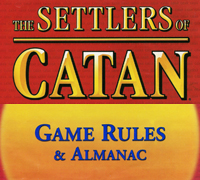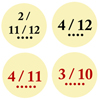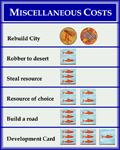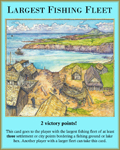

[ Home ] [ Travel ] [ Photography ] [ Pets ] [ Games] [ Rowing] [ Physics ]



![]()
![]()
Miscellaneous Additional Rules
Travel
Cruises
Past Cruises (Diaries)
Future Cruises
Rogues Galleries
Land Trips
Diaries (Land Trips)
Hawai'i - Big Island - 04'01
Hawai'i - Maui - 05'02
Hawai'i - Big Island - 04'03
Hawai'i - Kaua'i - 09'04
Hawai'i - Big Island - 04'06
Hawai'i - Maui - 04'06
Mainland China - 05'07
Phoenix, Arizona - 12'07
Greek Isles - 05'08
Hawai'i - Kaua'i - 09'08
Hawai'i - Big Island - 09'09
Hawai'i - Maui - 05'12
Hawai'i - Big Island - 04'13
Ireland - 08'13
Mexico - Cancun 11'13
France/Belgium/Lux 07'15
Hawai'i - Big Island - 05'17
England / Wales - 06'17
Hawai'i - Big Island - 09'19
Photography
Cameras
Underwater
Pets
Tara
Blackie
Whitey
Muffy
Ollie
Rusty
Fluffy
Rufus&Dufus
Games
Rowing
Physics
5. Additional House Rules
a) Special House Rules
- Citadel (see separate rules governing the citadel).
- Resource Tokens (see separate rules governing the resource tokens).
- Cities & Knights: Because the robber cannot attack before the first barbarian attack, rolls of "7" early in the game may advance the barbarians without providing any resource production. Therefore, when a "7" is rolled, it is ignored and the player rerolls the dice until something other than "7" is rolled. This means that the 7 card rule is void, but early in the game such a large number of cards is unusual. Once the barbarians have attacked, then rolls of "7" are treated normally.
- Cities & Knights: The two "Intrigue" cards are essentially useless. They should be removed from the game.
- When using the regular production number tokens, players tend to put settlements
on high probability hexes (5, 6, 8, 9) and shun the improbable hexes (2, 3, 11, 12). What
this does is to create large payouts when a 5, 6, 8 or 9 is rolled, and small payouts
when a 2, 3, 11 or 12 is rolled. We have created some "multi-number" combo tokens
to counteract this effect. The new tokens are as follows:
 2/3/12, 2/11/12, 2/10, 3/11 and 4/12 - these five combo tokens each
have a probability of 4/36, which is equivalent to either a 5 or
9 token.
2/3/12, 2/11/12, 2/10, 3/11 and 4/12 - these five combo tokens each
have a probability of 4/36, which is equivalent to either a 5 or
9 token.
- 3/10 and 4/11 - these two combo tokens each have a probability of 5/36, which is equivalent to either a 6 or 8 token.
b) Our Interpretation of Ambiguous Rules
- In Catan for 5 or 6 players, the inter-turn Special Building Phase (SBP) is considered a "turn". That means that a knight activation or development card purchase done during the SBP can be utilized immediately upon that player's next turn.
- A player can win during the inter-turn Special Building Phase (SBP) even though it is not immediately his turn. For example, achieving the longest road or building a city may put the player up to or over the winning VP score. Note that progress cards can only be "played" during the player's turn, so Victory Point cards earned outside of the player's turn cannot be counted until the player's turn arrives.
- In the 5-6 player expansion rules, the Special Building Phase (SBP) is defined as occurring at the end of a player's turn. Therefore, at the start of that game the first possible SBP occurs after the first player completes his turn. No building is possible before the first person rolls the dice.
- When playing Settlers or Seafarers, if a player purchases a development card on his turn, and it is a Victory Point, and it gives the player "game" points, then it may be played immediately and the player wins the game. Any other development cards must be retained until the player's next turn.
- If an opponent's knight placement "breaks" a player's route, any orphan roads or ships remain on the board as is. The ship movement rule continues to apply though, so orphan ships could be reused, one ship per turn.
- When using gold field hexes with Cities & Knights, the hex can only produce resources, never commodities.
- In Cities & Knights, a merchant can only be placed on a regular resource hex, not on a gold field hex.
- In Cities & Knights, the robber does not interfere at all with the operation of the merchant. If the merchant and robber are on the same hex, the 2:1 trading rate remains intact and the merchant is still worth one Victory point.
- During the hex production phase, if there are not enough cards of a given resource left in the bank to supply the entire requirement, then no one is given cards of that resource, even if there are a few cards to cover part of the requirement.
- The rules on the Commercial Harbour card differ from the rules for the same card in the manual. The disagreement relates to who chooses the commodity to be "stolen". We have sided with the manual where the opponent chooses which commodity he wishes to give to the requesting player (assuming he has at least one commodity in his hand).
- If a player is denied any resources or commodities on a dice roll (other than a "7") due to the robber being on a producing hex, should this qualify him to use the aqueduct benefit? Yes. The rules do not specifically mention this case, so we use the intention of the rules that "no resources" means "no resources" whether or not they are suppressed by the robber.
- In the original basic game, the placement rules for the robber were
simple - anywhere except a sea hex or the desert hex. Since then,
many more types of hexes have appeared and the rules have become
ambiguous. Our interpretation is that the robber may only be placed
on a hex that yields resources or commodities (ie. has a yellow production
number token). Here is a summary of where the robber can be placed:
- Yes - basic resource hexes (Forest, Pasture, Mountains, Hills, Fields), gold field hexes (from Seafarers of Catan), river resource hexes (Mountains, Hills, Pasture from Rivers of Catan). Another way to remember which hexes can be robbed is that these are the only hexes that have the yellow production number tokens.
- No - Desert hex, Sea hex, Lake hex (from Fishermen of Catan), Swamp hex (from Rivers of Catan), Oasis hex (from The Caravans), Castle hex (from Barbarian Attack), trade hexes (Castle, Quarry, Glassworks from Traders & Barbarians). Another way to remember which hexes cannot be robbed is that these hexes do not have any yellow production number tokens.
- The pirate only affects ship placement and movement. Hence, if it is placed on a sea hex that contains a fishing ground tile, the production of fish tokens is not affected.
- The double-hex Barbarian Tile can either be left as a stand-alone item beside the playing board or it can be integrated into the sea hexes as part of the playing board. If it is integrated, then for the purposes of ship placement, the double hex is treated as two plain sea hexes. The Barbarian Ship has no effect on any ships placed on the double hex.
c) Other Changes or Enhancements to the Game
 One annoying thing we found playing Cities & Knights and the
Fishermen of Catan, was continuously having to refer to the instruction
sheets to remember how to rebuild a destroyed city, or to see how many
fish could buy what. So, another modification that I did was to create
a Miscellaneous Costs card that detailed these rules. I printed
these on heavy card stock and attached them to the backs of the regular
Building Costs cards with 2 sided tape. This helped tremendously
as each player now has all of the building requirements right in front
of him. I have found several other similar cards on the Web where people
have created their own cards to provide the build options for Fishermen
of Catan. The difference is that I have added the cost of city repair
as well, as it is not provided on any other card. The new Traders
& Barbarians provides 4 similar cards for the Fishermen variant,
but these are the size of development cards and the writing is very
small. I like mine better!
One annoying thing we found playing Cities & Knights and the
Fishermen of Catan, was continuously having to refer to the instruction
sheets to remember how to rebuild a destroyed city, or to see how many
fish could buy what. So, another modification that I did was to create
a Miscellaneous Costs card that detailed these rules. I printed
these on heavy card stock and attached them to the backs of the regular
Building Costs cards with 2 sided tape. This helped tremendously
as each player now has all of the building requirements right in front
of him. I have found several other similar cards on the Web where people
have created their own cards to provide the build options for Fishermen
of Catan. The difference is that I have added the cost of city repair
as well, as it is not provided on any other card. The new Traders
& Barbarians provides 4 similar cards for the Fishermen variant,
but these are the size of development cards and the writing is very
small. I like mine better!
 A thought came to me as we were playing with the Fishermen of Catan
variant. It is possible to win (or at least do very well) without ever
building on a fishing ground tile. To give additional encouragement for
building there, I created a Largest Fishing Fleet card, worth 2
Victory Points. This card works like the Harbormaster card. You get one fleet point for
each settlement on a fishing ground (or lake hex), and 2 points for each city
(and 3 for a citadel). The first
player to achieve 3 fleet points gets the Largest Fleet card. If another player
exceeds this, he gets to steal the card. This gives added impetus to
strive for multiple fishing ground (and lake hex) spots.
A thought came to me as we were playing with the Fishermen of Catan
variant. It is possible to win (or at least do very well) without ever
building on a fishing ground tile. To give additional encouragement for
building there, I created a Largest Fishing Fleet card, worth 2
Victory Points. This card works like the Harbormaster card. You get one fleet point for
each settlement on a fishing ground (or lake hex), and 2 points for each city
(and 3 for a citadel). The first
player to achieve 3 fleet points gets the Largest Fleet card. If another player
exceeds this, he gets to steal the card. This gives added impetus to
strive for multiple fishing ground (and lake hex) spots.